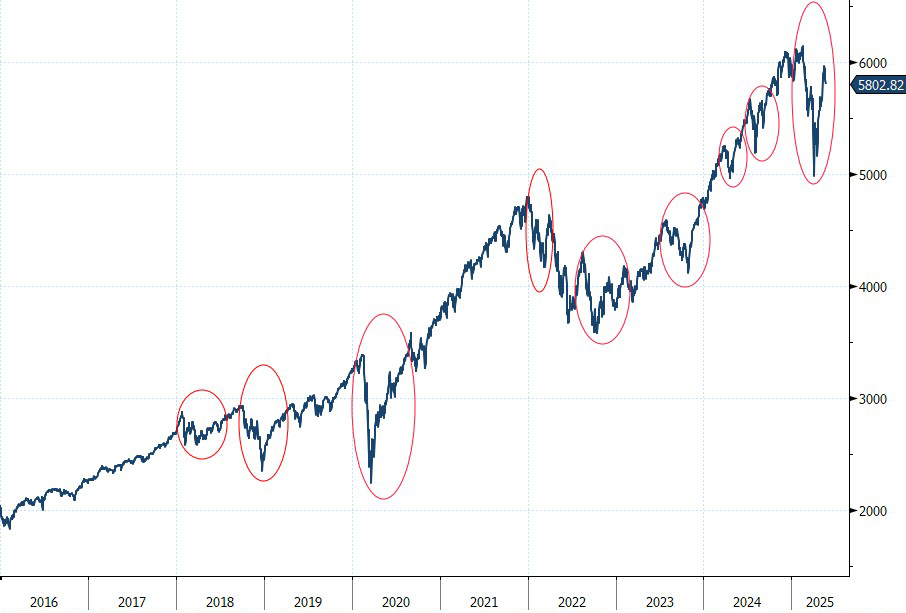It’s not about timing the market, but about time in the market
Marc Gruber – 03.06.25
Dear readers
On 2 April 2025, US President Trump declared ‘Liberation Day’ in a pretentious speech and announced a far-reaching tariff offensive that would affect almost all areas of the US economy. This decision triggered seismic panic selling on the global stock markets and led to one of the biggest corrections in the leading indices since the stock market crash of 2020. The volatility index (VIX), also known as the fear barometer, shot up to over 50 points. An average normal range is considered to be around 20 points.
However, anyone who thought that April marked the beginning of the end was mistaken. After the initial shock on the stock markets and the subsequent 90-day customs pause, calm returned surprisingly quickly. After a broad bottoming out of the stock markets, prices stabilised and continued to rise. Anyone who allowed themselves to be caught up in the broad sell-off mood at the beginning of April not only realised losses, but also missed out on the recovery. Those who remained calm and invested, on the other hand, were able to take the price gains after ‘Liberation Day’ in a relaxed manner.
It is in the nature of things that the temptation for investors to take action is high when there is a corresponding news situation in combination with greatly increased volatility. This is often done in the belief that they can outsmart the market. But history shows: Those who remain invested for the long term generally fare better. This is likely to be just as true in 2025 as it was in previous decades.
The past few weeks have clearly shown this: It is not the perfect timing that brings success. It is the time you give the market to work with your capital. The clear majority of investors are intent on finding the ‘perfect’ time to enter or exit investments, i.e. timing the market. The desire to buy when prices are at their lowest and sell when they are at their highest determines their behaviour. However, reality shows that even the most experienced professionals rarely manage to predict the market reliably. Short-term price fluctuations are often unpredictable and depend on many factors that no one can fully control.
In the past, the approach of patience and continuity has instead proven to be decisive for investment success. Historically, equity markets have risen over longer periods of time, despite interim setbacks and crises. This thesis is underpinned by the following chart. Over the past 10 years, price corrections of at least 5% have been followed within a very short time (one to four weeks) by significant price recoveries, which quickly made the original price setbacks seem insignificant again.

Chart of the US leading index S&P 500 since 31 December 2015
Looking back, it can be said that an investor who has consistently invested in a broadly diversified share index over the last 20 years has achieved a clearly positive return – despite the financial crisis, the coronavirus pandemic and geopolitical tensions. On the other hand, if you were inclined to constantly get in and out of stocks, you ran the risk of missing out on important upswings. Even a few missed days can significantly reduce the overall return. Long-term investments based on solid fundamentals often have a better chance of surviving market fluctuations. Volatile markets and short-term fluctuations are part of market behaviour.
Or, to put it this way: In the stock market, it’s not the fastest who wins, but the most patient. Sometimes it is advisable to simply do nothing – except stay invested. However, if your fingers are itching to act, anti-cyclical behaviour is advisable.
Until then, keep calm and invest on!

